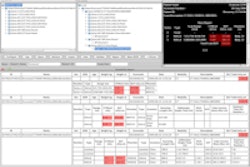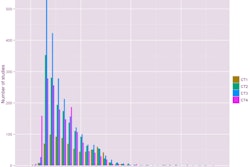
SAN FRANCISCO - California's recently passed radiation dose reporting law was the focus of the Society for Imaging Informatics in Medicine's (SIIM) first regional meeting, held October 24. Meeting attendees heard from state inspectors on how they plan to enforce the law, which could become a model for other states concerned about radiation overdose.
The dose reporting law, known as SB 1237, will impose strict new procedures and reporting requirements to protect patients from excessive doses of medical radiation when it goes into effect on July 1. The bill also provides an accreditation mandate for CT scanners that will take effect in July 2013, a change from the previous January 2013 date.
The law requires that radiation dose be recorded both on images and in a patient's health record, and that radiation overdoses be reported to patients, treating physicians, and the Department of Public Health (DPH). It requires the same level of monitoring for therapeutic radiation used to treat cancer.
During a question-and-answer session on October 24, Jerry Hensley, chief of x-ray inspection, compliance, and enforcement at the DPH, made it clear that California could act as a model for other states to enact their own radiation dose reporting bills -- giving this legislation a potentially wide-reaching effect.
"I get phone calls on a once-a-month basis from other states or agencies, and they're waiting to see what happens -- if we implode, explode, or what the public likes about [the law]," he said. "So they are watching and we're getting phone calls all the time."
The law assesses radiation in terms of CT dose index (CTDI) and dose-length product (DLP), measurements that are perhaps not as useful as they seem, according to SIIM presenter Robert Gould, ScD, a professor and vice chair of radiology for technology and capital projects at the University of California, San Francisco.
CTDI was formalized in 1981, prior to helical scanning and MDCT scanners. Furthermore, CTDI was crafted using 32-cm-thick plastic polymethyl methacrylate phantoms representing the body, and 16-cm plastic phantoms representing the head. The plastic is uniform, unlike the human body, which has varying degrees of thickness. CTDI is not really a measurement of patient dose, Gould said, but it's useful for comparing scanners.
In fact, Gould called using CTDI to explain radiation dose to patients "pap," or akin to baby food.
"We dumb it down so much that we present a single number when, in fact, it is more complex than that," Gould said. "CTDI is a useful measure. What is pap, in my opinion, is effective dose, which is not supposed to be used for an individual and which, to me, does not make sense to use in many circumstances."
What inspectors look for
The law stipulates states that DPH will inspect imaging facilities -- both at random and after reportable events, such as a radiation overdose. In terms of the inspections, Hensley's colleague Lisa Russell, an inspector at DPH, said they will be considerably different than the visits that DPH has conducted in the past.
"We're not going in there with our ... meter and actually verifying what your physicist has already done unless we really have to," she said.
The inspectors will watch CT scans and talk to technologists and maybe the radiologists. If they're going to a facility to investigate a reportable event, they will ask for a copy of the exam in question and the results of the investigation the facility has performed internally.
In terms of protocol oversight, inspectors will ask:
- Who determines imaging protocols?
- How are they set up?
- When are they reviewed? Does the facility review a few protocols every year, or all of the protocols every year?
- How many protocols does the facility have? How many different ones are there?
- Does every neuroradiologist on staff have his or her own protocol?
- Who is on call when the study is done?
- Are radiologists protocoling every study?
- If it's in the evening, is there a nighthawk service available for the technologist?
- If something goes wrong, who do they call? What do they do?
"We're hoping to see a little more standardization," Russell said. "We're not really looking for violations in this search; we're looking for oversight, we're looking for management, we're looking for involvement from the physicists, technologists, hospital management, and possibly risk management -- anyone in the whole chain who can best help reduce dose for the patient from excessive or unnecessary exposures."
Mostly, DPH inspectors are looking at policies and procedures that facilities have in place for training technologists, for making sure they know what to do, who to contact, and what their dose reference levels should be.
"At the beginning of the scan, if something looks out of line they need to know who to call, and they need to know they need to call," she said. "Not say, 'Oh no, it's two in the morning; I'll just go ahead and do whatever I think I need to do.' "
As far as enforcing the legislation, it's "not so much that we have the ability to levy heavy fines, but we do have a lot of cooperative power," Russell said, meaning that failure for adequate oversight in a radiology department is something that DPH's licensing and certification department is very interested in. The department is also interested in facilities that perform CT studies that may have questionable reimbursement value, she said.
The law is still being modified
Hensley was quick to point out that the administrative rules enforcing the legislation have not been finalized -- for example, DPH staff are drafting a question-and-answer section to help imaging facilities understand the law.
"We're writing the Q&A such that people understand what their options are. ... We want to make sure we comply with the law as it's written without making it too much of a real nightmare," he said.
One point that surprised many attendees of the SIIM symposium was that, currently, nonradiologists -- such as cardiologists -- are exempt from the law's radiation dose reporting requirements. The language of the legislation is such that it specifies "radiology reports."
It was pointed out during the meeting that radiologists are not the only ones conducting CT scans: Cardiologists account for a large chunk of the total number performed each year.
With clarifications such as these needed, Hensley asked SIIM symposium attendees for volunteers to help DPH draft its guidance documents. The opportunity for feedback on the law still exists, he said.




















